

The Apocalyptic Herbarium. Skip to Main Content Search Search Advanced Search User Tools Register Sign In.

Art. Art/Science. Art on Herbarium Sheets. Art with Dried Plants. Botanical Illustration. Botanical Illustrators. Botanist/Artist. Craft. Conceptual. Doing Art. Education. Embroidery. Florilegia. Fungi Art. Metaphor. Nature Prints.
Using Herbarium Collections. Today brings teeny, tiny treasures from the herbarium collection - lichen watercolours with ornate caligraphy . 1855-58, artist unknown. A Chromolithograph plate of ornamental gourds taken from the Album Benary. It was one of few early printed books offering fine-quality portraits of vegetable cultivars. Issued from 1876-1882 From the Lindley Library collection. Work by #HenrietteKnip (1783–1842) is included in the @FitzMuseum_UK exhibition "Scent from Nature: Beauty's botanical origins," on til Aug 29. Lupin, Cornflower & Carnation, by #HenrietteGeertruidaKnip, #hernaturalhistory.
Appeal to identify 'La Botaniste' who slipped from history. Mystery 19th Century botanist tracked down following appeal. La Botaniste – a lady in the margins. More botanical art from @NEE_Naturalist Archive @GNM_Hancock. This time Mr Pollard's watercolours of North American plants. Who was he? Any ideas? See. From Cacao to Clitoria: Luscious 19th-Century French Botanical Illustrations of the Most Vibrant Flora of the Americas. To put our familiar lives in perspective and jolt us awake to the wonder of so much we have come to take for granted, let us picture this: It is the 1840s and you, like most of humanity, have never traveled more than a few miles beyond where you were born, have never met a person native to a different country, have never seen a bird native to a different continent or a flower native to a different climate.
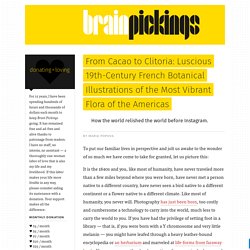
Like most of humanity, you never will. Photography has just been born, too costly and cumbersome a technology to carry into the world, much less to carry the world to you. NightSchool: Illustrating Science. Hand-coloured narcissi from L'Obel's Icones Stirpium, 1591. A bit out of season maybe, but it is time to get planting for next Spring! Women in Historical SciArt. I have focused a major part of my research into the women who created scientific illustrations from the 16th to early 20th centuries.

During this time, women were prohibited from higher education and from joining scientific organizations. These women found another way to pursue their love of science. Often self-taught in both science and art, they made great strides for the inclusion of women in science at all levels, and they contributed to the overall advancement of science despite discrimination. Your chance to give Botany a voice in a Fine Art project. Art holds a mirror up to nature, but how distorted is it?
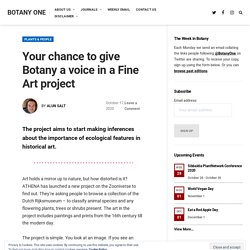
ATHENA has launched a new project on the Zooniverse to find out. They’re asking people to browse a collection of the Dutch Rijksmuseum – to classify animal species and any flowering plants, trees or shrubs present. The art in the project includes paintings and prints from the 16th century till the modern day. Spring flowers. A Treatise on Skeletonizing leaves to embellish Homes of taste published 1862. This is what I have been doing today - scanning watercolours of algae by George Stewardson Brady c1860. Specimen of Callithamnion rothii found in a cave at Hawthorn Dene, Co Durham. @NEE_Naturalist Archive.
The Recognition of Fruit—Graphic Records. Journal of Pomology and Horticultural Science, 1(1), 28–36. Europeana. Collaborations with artists go beyond communicating the science. Exhilarating, challenging, enlightening, stimulating, inspiring, fun.
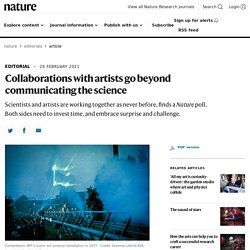
These were some of the words that Nature readers used to describe their experiences of art–science collaborations in a series of articles on partnerships between artists and researchers. Nearly 40% of the roughly 350 people who responded to an accompanying poll said they had collaborated with artists; and almost all said they would consider doing so in future. Such an encouraging result is not surprising. Public engagement has become essential to many research projects. BOTANICAL ATELIER – Botanical Atelier. 229 attachement catalogue. What’s So Abstract About Scientific Abstracts? The etymological root of the word links nonrepresentational art and the history of scientific publications.
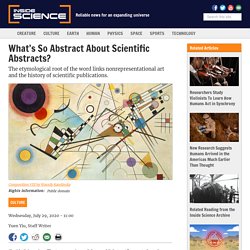
(Inside Science) -- The two meanings of the word “abstract” seem to be polar opposites of each other. One, as in an abstract painting, implies a disassociated and perhaps difficult-to-understand presentation, while the other, as in a scientific abstract, refers to a body of text that tries to explain complex research with clear and succinct language.
However, if you examine the history of the word through the ages, the two uses aren’t as different as they first appear. Interpretative art versus interpreting science. Art Nouveau in Danube Region. Craft and Aesthetics in Byzantine and Early Islamic Textiles – Khamseen. Craft and Aesthetics in Byzantine and Early Islamic Textiles Elizabeth Dospěl Williams Synopsis: Textiles counted among the most valuable category of luxury objects circulating in the Sasanian, Byzantine, and early Islamic periods (7th-9th centuries).

The British Library MS Viewer. Watching plant evolution on historical paintings. The evolution of food plants Many of the plants we eat have been domesticated and improved from a wild ancestor.
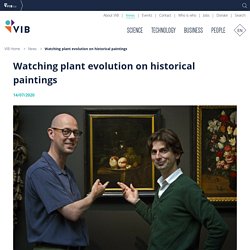
Often, this has led to a very different appearance, for example bigger fruits, no thorns, and so on. Plant Flagging and the Queer Ecology Hanky Project — Lady Science. In the 1970s, some gay men in San Francisco and New York used a "hanky code" to signal what kind of sexual activity they were looking for while cruising.
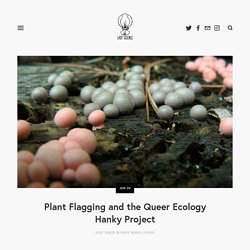
As described in The Leathermen's Handbook II, certain hankies signaled common activities: dark blue for anal sex; light blue for oral sex; red for fisting; black for S&M. A hanky on the left signaled a desire to top, while a hanky on the right signaled an aim to bottom. Apochryphally invented by gay retailers looking to sell off unpopular bandana colors, the hanky code was always partly ironic. The code gradually became so elaborate that few could keep up with it, with hanky colors sometimes signalling rather niche practices. Tristan Hoare. Tristan Hoare is delighted to present Botanica, an exhibition curated with Flora Goodwin and Omar Mazhar, which focuses on the work of a diverse group of artists who have sought their inspiration from the natural world.

From ancient times through to today, artists have interpreted nature in different ways and for different purposes. Today art is constantly categorised, but by stepping back and looking from a wider angle we find artists from different times and cultures employing a multitude of techniques, who have sought inspiration from a universal beauty in the natural world. The genesis of Botanica are the paintings by Rory McEwen, an artist widely regarded as the greatest botanical artist of the twentieth century. What Can Art Teach Us About the History of Plant Cultivation? A Lot, It Turns Out—Via Something Called #ArtGenetics. The fruits and vegetables we eat today have come a long way from their wild ancestors, thanks to millennia of domestication and cultivation. And throughout history, artists have captured the appearance of plant-based foods, unwittingly offering a window into food’s genetic past.
Origins of Science as a Visual Pursuit. Reflection of the Wren Library on the river Cam © frscpsd Welcome to the website for ‘Origins of science as a visual pursuit’. This website functions as a forum for friendly and helpful exchange of views and comments among participants of an AHRC international network which focuses on the early Royal Society. We also realize that the visual aspects of knowledge in pre-modern Europe are of interest to a wider group of scholars. So we invite our colleagues to post reviews of papers, books, meetings, and exhibitions; introduce ongoing work, up-coming meetings, useful resources, out-of-the-way references and papers that could be of interest. We also encourage dialogue by commenting on others’ posts and helping with questions posed. Copyright and the Use of Images as Biodiversity Data. Article metadata Introduction Images as a form of biodiversity data Achieving standard approaches Consistency over time Forms of Images Rights and scientific images Numerus clausus of Intellectual Property Rights Copyright Database protection Protection against unfair competition Specific photograph protection in some European countries Discussion Rights in scientific images apply only in special cases Blue2 - an updated “Blue List” Exceptions and limitations, fair use No economic incentive Law and opinions Attribution Acknowledgements References Supplementary files.
The timeless pleasure of looking at plants. The Carrara Herbal – Sarah Kyle’s Pandora’s box. Sarah R. Kyle, Associate Professor of Humanities, University of Central Oklahoma, has just published a book Medicine & Humanism in Late Medieval Italy: the Carrara Herbal in Padua (Routledge 2016). For a discount code, see Routledge brochure pdf Here is her story about her encounter with the manuscript. The day the Carrara Herbal arrived at my desk at the British Library I felt like I was opening Pandora’s Box.
George Clifford Herbarium and ornaments. St Andrews Herbarium sur Twitter : "Did Charles Howie (1811-1899) use wall paper for the covers of his collection of Fife algae? Plant Illustrations. The Met: Botanical Imagery in European Painting. Biodesign Exhibition RISD. Wall Street International Magazine. Great marginal interest. Herb Robert, pansy etc. 16C book of hours (& flowers). The Europeum, National Museum, Krakow.… La Nature en images. Plantes, animaux et minéraux ont donné lieu à de superbes ouvrages illustrés. L’histoire naturelle se prête particulièrement bien à l’image, et une intention scientifique n’exclut pas de réelles qualités esthétiques. La postérité a retenu les noms de Redouté, le « Raphaël des fleurs », ou d’Audubon, aux planches d’oiseaux grandeur nature. On pourrait également citer Nicolas Robert, peintre des Vélins du roi, ou Maria Sibylla Merian, illustratrice et entomologiste. Les manuscrits médiévaux décrivent les différentes espèces connues, reprenant les auteurs antiques.
Les Grandes Découvertes bouleversent cette vision du monde par l’arrivée de milliers d’espèces inconnues, qu’il faut décrire, nommer et représenter. Flowering of florence botanical. Wallace Statue. 18TH CENTURY EAST INDIA TEXTILE TRADE. This website is using a security service to protect itself from online attacks. The service requires full cookie support in order to view the website. Please enable cookies on your browser and try again. Reference ID: 9449a0287ab7dbb63597e16d5b517fc1.